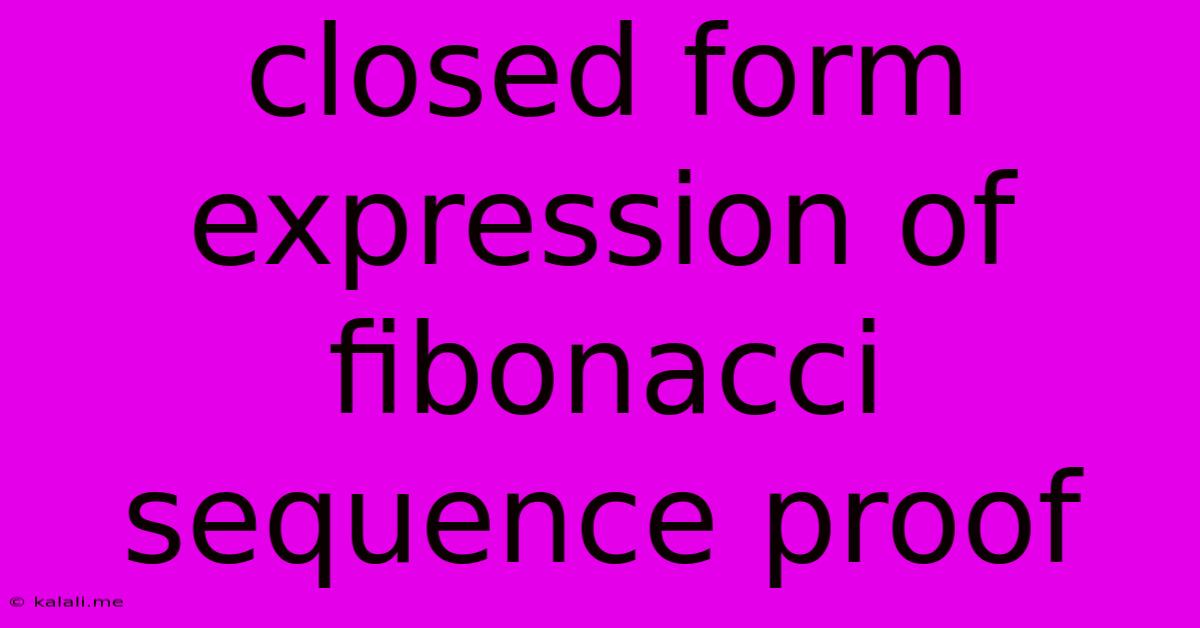Closed Form Expression Of Fibonacci Sequence Proof
Kalali
May 22, 2025 · 3 min read

Table of Contents
Closed-Form Expression of the Fibonacci Sequence: Proof and Applications
The Fibonacci sequence, a series of numbers where each number is the sum of the two preceding ones, starting with 0 and 1, has fascinated mathematicians for centuries. Its elegant simplicity belies a deep mathematical richness, particularly its representation through a closed-form expression, also known as Binet's formula. This article will explore the proof of this formula and delve into its practical applications. Understanding Binet's formula provides a powerful tool for directly calculating any Fibonacci number without iterative computation.
Understanding the Fibonacci Sequence and the Need for a Closed-Form Expression
The Fibonacci sequence (F<sub>n</sub>) begins: 0, 1, 1, 2, 3, 5, 8, 13, 21, 34, ... Defined recursively, F<sub>n</sub> = F<sub>n-1</sub> + F<sub>n-2</sub>, with F<sub>0</sub> = 0 and F<sub>1</sub> = 1. While this recursive definition is elegant, calculating larger Fibonacci numbers becomes computationally expensive. A closed-form expression offers a much more efficient method.
Binet's Formula: The Closed-Form Expression
Binet's formula provides a direct way to calculate the nth Fibonacci number:
F<sub>n</sub> = (φ<sup>n</sup> - ψ<sup>n</sup>) / √5
where:
- φ = (1 + √5) / 2 (the golden ratio)
- ψ = (1 - √5) / 2
This formula might seem surprising, involving irrational numbers to calculate a sequence of integers. However, the irrational components neatly cancel out, resulting in an integer value for F<sub>n</sub>.
Proving Binet's Formula
The proof involves several steps and leverages the concept of solving linear recurrence relations. Here's an outline:
1. The Characteristic Equation:
The recursive definition F<sub>n</sub> = F<sub>n-1</sub> + F<sub>n-2</sub> can be expressed as a characteristic equation:
r<sup>2</sup> - r - 1 = 0
Solving this quadratic equation yields the roots:
r<sub>1</sub> = φ = (1 + √5) / 2 r<sub>2</sub> = ψ = (1 - √5) / 2
2. The General Solution:
The general solution to the recurrence relation is given by:
F<sub>n</sub> = Aφ<sup>n</sup> + Bψ<sup>n</sup>
where A and B are constants to be determined.
3. Determining the Constants:
Using the initial conditions F<sub>0</sub> = 0 and F<sub>1</sub> = 1, we can create a system of two linear equations:
- A + B = 0
- Aφ + Bψ = 1
Solving this system gives:
A = 1/√5 B = -1/√5
4. Substituting the Constants:
Substituting the values of A and B back into the general solution gives Binet's formula:
F<sub>n</sub> = (φ<sup>n</sup> - ψ<sup>n</sup>) / √5
Applications of Binet's Formula
Binet's formula has numerous applications beyond simply calculating Fibonacci numbers:
- Efficient Computation: Calculating large Fibonacci numbers is significantly faster using Binet's formula than using the recursive definition.
- Analysis of Algorithms: The Fibonacci sequence appears in various algorithms, and Binet's formula aids in analyzing their time complexity.
- Mathematics and Physics: The Fibonacci sequence and the golden ratio appear unexpectedly in various areas, from botany (phyllotaxis) to art and architecture. Binet's formula provides a theoretical framework for understanding these connections.
- Financial Modeling: The Fibonacci sequence and the golden ratio are used in technical analysis in finance, particularly in identifying potential support and resistance levels in asset prices.
Conclusion:
Binet's formula provides a powerful and elegant closed-form expression for the Fibonacci sequence. Its derivation, while involving some algebraic manipulation, showcases the beauty and interconnectedness of mathematical concepts. The formula's wide-ranging applications highlight its importance in diverse fields, cementing its place as a cornerstone of mathematical understanding.
Latest Posts
Latest Posts
-
How Many Cups Is 1 Pound Of Cheese
Jul 12, 2025
-
30 X 30 Is How Many Square Feet
Jul 12, 2025
-
How Much Does A Half Oz Weigh
Jul 12, 2025
-
Calories In An Omelette With 3 Eggs
Jul 12, 2025
-
How Do You Say Great Grandmother In Spanish
Jul 12, 2025
Related Post
Thank you for visiting our website which covers about Closed Form Expression Of Fibonacci Sequence Proof . We hope the information provided has been useful to you. Feel free to contact us if you have any questions or need further assistance. See you next time and don't miss to bookmark.